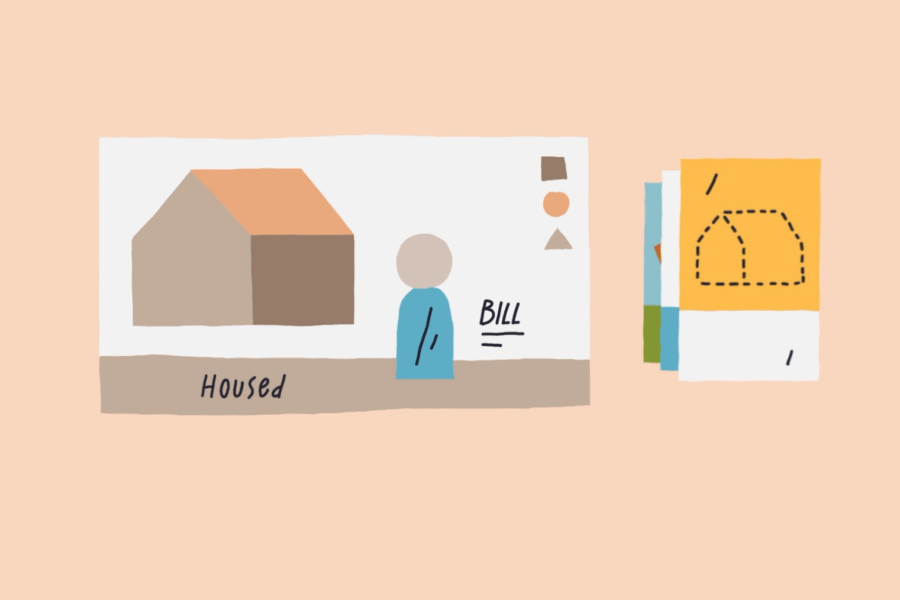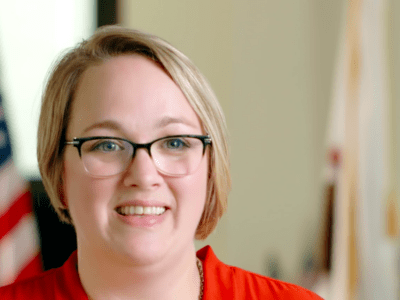What’s the most immediate way to end a person’s homelessness? Provide them with a safe and stable home.
This concept is brought to life through the philosophy and approach called “Housing First,” which prioritizes giving people permanent housing, without preconditions, like mandatory treatment programs, sobriety, or other services. This approach highlights the need for stable, secure housing above all, which then serves as a solid foundation for further supportive services.
What is “Housing First?”
Housing First is a recovery-oriented, evidence-based philosophy and approach that recognizes that housing is a basic human right, and that people are better equipped to make progress in their lives if they have a safe, stable place to live. Through Housing First, people can access permanent housing without having to meet any prerequisites, like sobriety or the completion of programs, that are not required of any typical renter.
Housing First recognizes that homelessness is, first and foremost, a housing crisis, which can be addressed and resolved by providing safe, affordable housing. This approach prioritizes people’s basic needs, like food and shelter, above less critical necessities such as employment, income, or sobriety.
Housing First is most commonly implemented through permanent supportive housing and rapid rehousing. Permanent supportive housing (PSH) is aimed at families and individuals who have experienced recurring or long-term homelessness and have chronic medical illnesses, disabilities, mental health conditions, or substance use disorders. Permanent supportive housing pairs wraparound supportive services with long-term rental assistance.
Rapid re-housing (RRH) offers short-term assistance for individuals and families across many different circumstances. Rapid re-housing provides services and resources customized to the specific needs of each individual or family, which can include rental assistance, housing navigation services, and case management
Housing First is also guided by the belief that a person should have agency in both their housing choice and participation in services. This approach supports the idea that people experiencing homelessness have the right to self-determination, respect, and dignity — and that everyone is “housing ready.”
Making support and services voluntary has been shown to make it more likely for people to actually use available services, which ultimately promotes housing stability and well-being. In fact, many people experience improvements in quality of life as a result of being housed.
Video: learn what Housing First means
Does Housing First mean “housing only?”
No — as mentioned, Housing First is typically operationalized under two types of program models, permanent supportive housing and rapid re-housing. Permanent supportive housing offers voluntary wraparound services, like case management, employment support, and community-based health care. Both programs are tailored to the specific needs and preferences of the person participating, recognizing that no one has the same needs — except for safe, stable, and affordable housing.
Research has demonstrated that uptake of these voluntary services increase when people have a stable place to call home. In turn, these wraparound services prevent returns to homelessness and increase housing stability and overall well-being. A person participating in the rapid rehousing or permanent supportive housing program can choose to engage with services at any time. However, a person will not lose their home if they choose to not participate in these supportive services.
How do we know Housing First is effective?
Research has demonstrated that the Housing First approach is an effective solution to more quickly and permanently resolve an individual’s homelessness.
According to NAEH, research has demonstrated that permanent supportive housing programs have long-term retention rates of up to 98%, while rapid-rehousing can help people exit homelessness as quickly as an average of two months, and remain housed. Research has revealed that between 75 and 91% of households remain housed a year after participating in a rapid re-housing program.
Numerous studies find that Housing First ends homelessness for chronically homeless individuals faster, more often and more permanently than treatment-based approaches. Additionally, the majority of Housing First tenants do not return to homelessness, remaining stably housed at rates that often exceed those of their counterparts in traditional treatment-first programs.
Studies have shown that Housing First programs reduce interactions with services like hospitals, jails, or shelter, which also result in measurable cost savings for communities. In one large, multiple-site research trial, results demonstrated that the cost of launching a Housing First program paired with intensive case management services was offset by half due to reductions in costs of visits to shelters, emergency departments, and other crisis services.
According to the National Alliance to End Homelessness, one study found an average cost savings on emergency services of $31,545 per person housed in a Housing First program over the course of two years. Another study showed that a Housing First program could cost up to $23,000 less per consumer per year than a shelter program.
A 2014 study found the cost of homelessness in Central Florida to be $31,065 per year, stemming primarily from inpatient hospitalizations, emergency room fees, and criminal justice costs. In contrast, providing permanent housing for these individuals experiencing chronic homelessness costs just $10,051 per person/year — one-third the cost of leaving these individuals unsheltered.
Research on permanent supportive housing has shown that a majority of people participate in optional supportive services, which can often result in increased housing stability. One study found that families using these supportive services are more likely to successfully manage their household budget, participate in job training programs, retain stable employment, or attend school. Moreover, people opting into these services spent fewer days in the hospital than those who did not.
Who supports Housing First?
Housing First has been supported on both sides of the aisle. Housing First has been supported by the George W. Bush, Barack Obama, and Joe Biden administrations, along with the U.S. Departments of Housing and Urban Development (HUD) and Veterans Affairs (VA), Substance Abuse and Mental Health Services Administration (SAMHSA), and U.S. Interagency Council on Homelessness (USICH). Housing First is supported by the VA in its two largest homelessness programs – Supportive Services for Veteran Families (SSVF) and HUD-Veterans Affairs Supportive Housing (HUD-VASH).
The Housing First model is also used by a variety of faith-based organizations, which often operate permanent supportive housing and rapid rehousing programs that utilize Housing First. Many different faith traditions uphold the belief in the dignity, worth, and autonomy of each individual, focusing on serving each person’s needs, no matter their background or beliefs.
For example, the housing services of Catholic Charities of the Archdiocese of Chicago take a Housing First approach, prioritizing providing permanent housing to people experiencing homelessness in order to quickly end their homelessness, rather than requiring them complete service programs or address other challenges first.
How did Housing First emerge?
Housing First was developed in the 1990s by a clinical psychologist named Dr. Sam Tsemberis, while working with the housing nonprofit Pathways to Housing in New York. The approach emerged as a response to the more “linear” or “stairstep” models that were more prevalent at the time, in which people experiencing homelessness had to follow a linear path to obtain permanent housing, with the requirement that they participate and complete short-term treatment or residential programs first.





